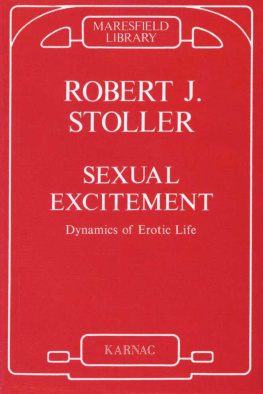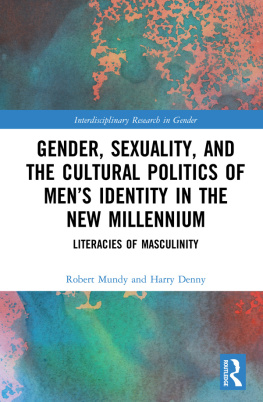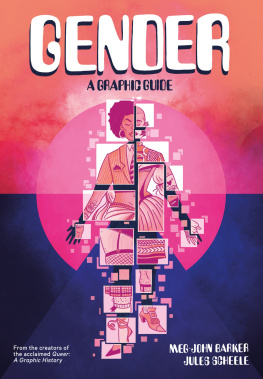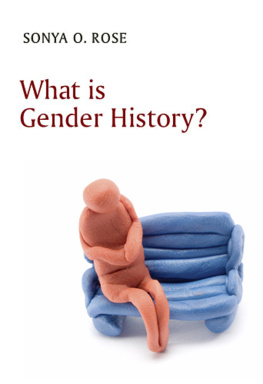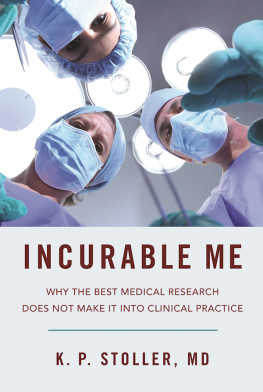Robert J. Stoller - Sex and Gender: The Development of Masculinity and Femininity
Here you can read online Robert J. Stoller - Sex and Gender: The Development of Masculinity and Femininity full text of the book (entire story) in english for free. Download pdf and epub, get meaning, cover and reviews about this ebook. year: 1984, publisher: Karnac Books, genre: Romance novel. Description of the work, (preface) as well as reviews are available. Best literature library LitArk.com created for fans of good reading and offers a wide selection of genres:
Romance novel
Science fiction
Adventure
Detective
Science
History
Home and family
Prose
Art
Politics
Computer
Non-fiction
Religion
Business
Children
Humor
Choose a favorite category and find really read worthwhile books. Enjoy immersion in the world of imagination, feel the emotions of the characters or learn something new for yourself, make an fascinating discovery.
- Book:Sex and Gender: The Development of Masculinity and Femininity
- Author:
- Publisher:Karnac Books
- Genre:
- Year:1984
- Rating:5 / 5
- Favourites:Add to favourites
- Your mark:
- 100
- 1
- 2
- 3
- 4
- 5
Sex and Gender: The Development of Masculinity and Femininity: summary, description and annotation
We offer to read an annotation, description, summary or preface (depends on what the author of the book "Sex and Gender: The Development of Masculinity and Femininity" wrote himself). If you haven't found the necessary information about the book — write in the comments, we will try to find it.
Sex and Gender: The Development of Masculinity and Femininity — read online for free the complete book (whole text) full work
Below is the text of the book, divided by pages. System saving the place of the last page read, allows you to conveniently read the book "Sex and Gender: The Development of Masculinity and Femininity" online for free, without having to search again every time where you left off. Put a bookmark, and you can go to the page where you finished reading at any time.
Font size:
Interval:
Bookmark:
The Development of Masculinity and Femininity
Professor of Psychiatry,
Department of Psychiatry,
School of Medicine
University of California at Los Angeles
MARESFIELD LIBRARY
LONDON
KARNAC BOOKS
For Sybil
Personal Acknowledgments
This is no way to pay debts, and I set about it reluctantly, for I owe more (and should like to be more personal and private about it) than the listing below permits. However, the reader should at least know that these are my friends and colleagues, the research team which helped shape the form of this book:
Howard J. Baker, m.d.
Peter M. Bender, ph.d.
Edward L. Burke, ph.d.
Hannah Fenichel, ph.d.
Harold Garfinkel, ph.d.
Richard Green, m.d.
Ralph R. Greenson, m.d.
Martha J. Kirkpatrick, m.d.
Nathan Leites, ph.d.
Leonard Loren, m.d.
G. Craig MacAndrew, ph.d.
Lawrence E. Newman, m.d.
Alexander C. Rosen, ph.d.
Alan S. Ruttenberg, m.d.
Richard W. Shearman, m.a.
Donald G. Siegel, m.d.
Richard E. Whalen, ph.d.
Robert Zaitlin, m.d.
I wish especially to thank Dr. Greenson and Dr. Leites; their thoughts and enthusiasm are present throughout, enriching areas that had been very underdeveloped.
My secretary, Thelma Guffan, did her usual superb job. Without her, the book would still be unfinished.
Finally, the generosity of Mrs. Lita Hazen and of the Foundation for Research in Psychoanalysis has given a continuing stability to all of us in the Gender Identity Research Clinic at UCLA.
In the last fifteen years or so, an increasing interest and an increasing body of information have been developing in the study of sexuality. During this time, advances have been made by geneticists, embryologists, biochemists, neurophysiologists, endocrinologists, and others studying the biological substrates to human sexual behavior, while the studies of zoologists and psychologists on lower animals and the collecting by clinicians of masses of data by interviews, questionnaires, and actual observations of the physiology of sexual excitement, have also contributed to the crescendo of interest and information. As in many other areas of the study of human behavior, this new information has outstripped a capacity to synthesize it, a wholesome change from the not too distant past when scholars felt freer to philosophize without the encumbrance of data.
It is not the task of this present work to attempt such a synthesis. However, within discrete areas there has been a congealing of concepts and theories around some of the new data, and it is in one of these circumscribed areas that I have been working and thinking for the past ten years. This book reports on those findings which permit some generalization, and so I wish now to present information regarding the development, maintenance, and manifestations of masculinity and femininity, and also to discuss certain syndromes, the findings of which seem to cluster around describable etiologies, and to express some preliminary thoughts regarding treatment.
While the work of our research team has been associated with the term gender identity, we are not militantly fixed either on copyrighting the term or on defending the concept as one of the * splendors of the scientific world. It is a working term. We know that though it deals with another realm of feelings, thoughts, and behavior than that encompassed by, say, sexml activity, the two terms are contiguous and at times inextricably intermingled. With gender difficult to define and identity still a challenge to theoreticians, we need hardly insist on the holiness of the term gender identity.
One need notone cannotsummarize the literature in which sex, sexuality, and such terms are used; then, too, there is the problem that one is often confused when an author uses such a term before he has carefully described the data to which he is referring. For instance, the word sexuality usually does not communicate much, for it covers so much. Trying to be more precise, we have split off gender as a distinguishable part of sexuality.*
Dictionaries stress that the major connotation of sex is a biological one, as, for example, in the phrases sexual relations or the male sex. In agreement with this, the word sex in this work will refer to the male or the female sex and the component biological parts that determine whether one is a male or a female; the
* As did Freud years ago (iqzo) in The Psychogenesis of a Case of Homosexuality in a Woman,"tf in which he listed three characteristics of (homo)sexu-ality: (i) physical sexual characters; (2) mental sexual characters (what we are now calling gender ); and (3) object choice. He said these up to a certain point, vary independently of one another, and are met with in different individuals in manifold permutations.
t This and other superscript figures used throughout refer to the numbered references to publications consulted found under chapter headings at the end of the book. (Shortened titles are used, each work being cited in full in the Bibliography.) f.d.
word sexual will have connotations of anatomy and physiology. This obviously leaves tremendous areas of behavior, feelings, thoughts, and fantasies that are related to the sexes and yet do not have primarily biological connotations. It is for some of these psychological phenomena that the term gender will be used: one can speak of the male sex or the female sex, but one can also talk about masculinity and femininity and not necessarily be implying anything about anatomy or physiology. Thus, while sex and gender seem to common sense to be practically synonymous, and in everyday life to be inextricably bound together, one purpose of this study will be to confirm the fact that the two realms (sex and gender) are not at all inevitably bound in anything like a one-to-one relationship, but each may go in its quite independent way.
This first became clearly evident in those monumental works The Interpretation of Dreams and Three Essays on Sexuality, wherein Sigmund Freud forced the world to recognize that much of what was called sexuality was determined by ones life experiences from infancy on and was not simply a matter of inheritance, biochemistry, and other organic factors. While his work was amplified and refined by subsequent analysts, no such profound or simple statement has supplemented or supplanted Freuds original work.
In recent years, building directly upon this knowledge of postnatal learning experiences as essential to sexuality, Money and the Hampsons have clearly drawn the thesis that sex and gender are not necessarily in a one-to-one relationship. To develop this thesis, they have turned especially to natural experiments, in which the variables of sex and gender have been manipulated by fate. For example, they cite that classical experiment in which two children are born with adrenogenital syndrome; both are genetically, gonadally, and endocrinologically female and have the normal internal sex structures of females, though their external genitalia are masculinized. If at birth one of these children is correctly designated as a female and the other incorrectly labeled a male because of the apparently male genitalia, by the time these children are about five years old, the one who was unequivocally believed to be a girl has no question but that she is a girl and the one believed to be a boy knows he is a boy. What determined the gender behavior of these children, then, was not their sex (biological) but their postnatal life experiences, a very complicated process that begins with the authoritative labeling of the infant by society as being male or female.
So much for the moment for sex and gender. As regards the word identity , my treatment of that word will not be more adequate. The purpose of this work is not to arrive at a comprehensive or even useful definition of the term identity , or to enter into the controversies now very much in the forefront of psychoanalytic theorizing as to the differences and similarities, usefulness or distortions of such terms as ego, self, self-representation, identity , sense of identity and the like.* At this point in my studies, I am using the word identity to mean ones awareness (whether one is conscious of it or not) of ones existence and purpose in the world or, put a bit differently, the organization of those psychic components that are to preserve ones awareness of existing. After much struggle, I cannot see, when actually observing a person, what is identity as different from self, ego identity, self-representation, and so forth. All the efforts at definition in the literature blur terribly for me in facing real life.
Font size:
Interval:
Bookmark:
Similar books «Sex and Gender: The Development of Masculinity and Femininity»
Look at similar books to Sex and Gender: The Development of Masculinity and Femininity. We have selected literature similar in name and meaning in the hope of providing readers with more options to find new, interesting, not yet read works.
Discussion, reviews of the book Sex and Gender: The Development of Masculinity and Femininity and just readers' own opinions. Leave your comments, write what you think about the work, its meaning or the main characters. Specify what exactly you liked and what you didn't like, and why you think so.



